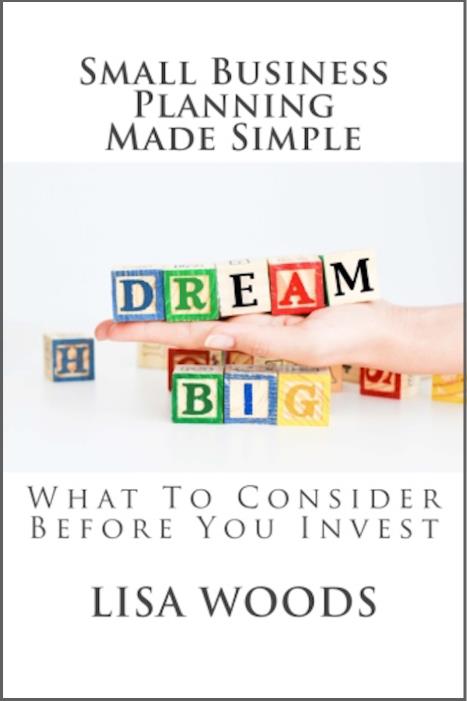Ready to start-up or expand your small business? Use this template and guidebook to organize your thoughts and develop insight into important areas you may not have even considered yet.
Business Plan Template
It's a complete list of what you need to think through for a successful business startup.
Included in this template...
- 15 components to a sound business plan
- Detailed questions you can answer to populate each component of your plan
- FREE Download

Need More Than Just A Template?
For each of the 15 Business Plan Components outlined in the template, our guidebook, “Small Business Planning Made Simple-What to Consider Before You Invest” takes you through the thinking process so you can develop each part of your plan.
The guidebook includes examples of...
- organizational charts
- sales plans
- income statements
- investment plans
- market share estimates
- Return on Investment & Break Even Analysis samples
- and much more
The guidebook explains how to use this information so you can make important decisions about the feasibility of your dream.
** There is also a unique section of the book titled “Common Risks & Opportunities.” Once you’ve finished writing your plan, you can use this information to go back and improve upon some areas that have a tendency to be weak points. Learn from our experience and overcome these hurdles during the planning process - avoiding common pitfalls that many business owners before you spent time and money correcting after it was too late.
Here is the link to our guidebook available on Amazon:


Why Is This Important To You?
- According to the Small Business Administration, 50% of new businesses fail within the first 5 years.
- The majority of business failures are due to poor planning, misreading market demand and incorrectly budgeting expenses.
- Small business plans tend to be focused around what the entrepreneur knows, leaving what they don’t know to be brushed over.
- Most business plan templates are limited, and generic, they don’t provide any guidance as to why information is important or how to use that information to make informed decisions about your business.
- A sound business plan should prove to you (and investors) that your opportunity and strategy are actually viable…as well as expose areas that put your business at risk.
15 Components Included in Our Business Plan Template & Guidebook
1. General Business Information:
This section of your business plan is meant to define basic information about you, your business and how you got to this point in the first place.
2. Business & Financial Objectives:
This section of your business plan is meant to define the financial investment required to start up or expand the business, the sales estimates and growth patterns over the course of the business plan, as well as the break even point for the business (how long it will take to make a profit).
3. Business Systems:
This section of your business plan details the tools you will use to manage the day-to-day operation. A system can be as simple as a pre-printed notebook, an excel spreadsheet, or as complex as industry specific software that can be used to create a competitive advantage. The point is to define what your business will use so those costs (if any) can be incorporated into your plan. If a specific system requirement does not apply to you, just be clear on that point. For example, if you don’t plan on having employees, you won't need a payroll system to manage them!
4. Operating Costs & Organizational Structure:
This section of your business plan defines who will be responsible for each job in your company, as well as how your operating costs will be structured.
5. Business Ramp-Up:
This section of your business plan defines the starting point of your business and its progression over the course of the business plan. It also provides an opportunity to outline future growth strategies (phases two or three) that would take place beyond the initial business plan, once that plan is successful.
6. Business Metrics:
This section of your business plan is meant to define the key parameters that will track and measure the plan’s success. Business Metrics are essential to keeping you, the business owner, focused on achieving your results. It is so easy to get sidetracked and distracted by opportunities, new ideas, or just the chaos of the day-to-day. But by defining and visually focusing on your key results, you open the door to understanding what’s working and what’s not, as well as provide yourself with insight to modify your activities if your current activities are not working well enough to achieve your plan. This visibility increases the likelihood of business success because you can see in advance if problems are coming down the road…and fix those problems before it’s too late.
7. Marketing Plan:
This section of your business plan defines the group of people that you believe are (or will be) interested in purchasing your products or services. It details the actions you will take to proactively communicate with those people, and the key messages you will use to convince them to do business with you instead of your competition.
8. Startup Resources:
This section of your business plan details how you will pay for your business and support yourself until your business can make enough money to do both on its own.
9. Administrative Resources:
This section of your business plan defines outside services required to support the business, as well as the monthly or yearly fees associated with those services.
10. Employment Plan:
This section of your business plan defines the employees necessary to achieve your goals. If you are forming a company that will not have any employees, then you can skip this section.
11. Future Expansion Plans:
This section of your business plan defines how your business structure may change over time. Examples of expansion include moving to a larger location, entering into additional geographic regions, as well as adding additional products/services to your mix. Expansions typically happen once growth milestones are reached. This is the longer term, strategic plan for your business - your vision beyond the startup period.
12. “Gut” Check:
This section of your business plan defines potential startup risks, how to avoid those risks, as well as a short-term action plan to ensure you succeed in doing so.
13. Investment Breakdown:
This section of your business plan defines the specific items you need to purchase in order to start your business. It’s important to itemize costs and timelines for each purchase, as well as consider more than one investment path so that you have options just incase adjustments need to be made.
14. Financials:
This section of your business plan defines the income and cash flow projection for your business startup. It will tell the story of your business in the form of a spreadsheet, showing the sales evolution of specific products or services, the operating expenses in relationship to sales, and most importantly, when and how much profit your business will make.
15. Executive Summary:
This section of your business plan provides an overview of the Who, What, Why, How & When of the business. It is the first section you read at the beginning of the plan, however it is the last section you write when preparing the plan itself. The Executive Summary is just that, a summary of the business plan. Everything in the summary should come from the plan itself, don’t reinvent the wheel.
Our goal is to teach what is important, why it’s important and how to use the information to run your business…so that you can build a sound business plan that is the foundation for making your dream a successful reality.